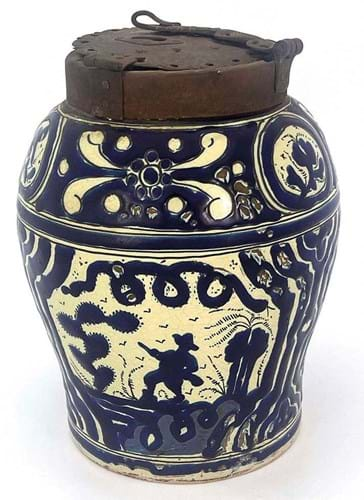Their value was such that the vessels made to contain them were usually lockable to prevent pilfering from the servants. These tin-glazed earthenware chocolate jars, known as chocolatero, were typically locally made.
The type known as Talavera poblana was produced in the central Mexican town of Puebla from the beginning of the 16th well into the 18th century.
The name probably refers to the maiolica-producing city of Talavera de la Reina in Spain that was the source of many fashionable imported ceramics.
But Puebla was well-suited to ceramics production due to the availability of fine local clays, tin and lead and its proximity to newly established churches and monasteries that demanded tiles, domestic vessels and decorative wares.
Like its Spanish prototypes, Talavera poblana borrows heavily from European, Islamic and Chinese ceramics. All were available to wealthy and cosmopolitan Spain during this period and also influenced Mexico during the colonial period. Large quantities of Chinese porcelain could be found in Mexico, brought there as part of the Manila galleon trade, and much of the local pottery was inspired by Ming blue and white.
According to the 1653 ordinances of the Puebla potter’s guild, “the fine ware must be painted in the manner of the ceramics of China, very blue, made in the same manner with relief in blue”. Many jars took the form of Chinese guans.
But potters in Puebla did not just slavishly copy Chinese designs
The blue and white slip decoration to the 13in (33cm) early 18th century chocolate jar offered at Kinghams’ auction in Moreton-in-Marsh on October 6 shows a curious mix of chinoiserie and South American flora and fauna.
Figures wearing broad-brimmed hats figures tend to gardens of cactus. Made in the early 18th century during the so-called ‘Golden Age of Talavera’, it is fitted with hand-forged iron collars and covers that would lock with a key.
These cross-culture objects are rare visitors to UK regional sales. This one, that came for sale from a client in Devon with a guide of £300-500, found plenty of admirers before selling at £4400 (plus 25% buyer’s premium). The buyer was from Arizona.















